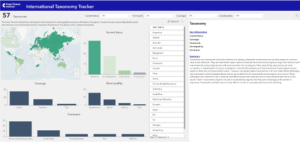Enabling active transitions through international taxonomies
by

In the battle to align financial flows with the terms of the Paris Agreement, access to decision-useful climate related financial disclosures will be key. Taxonomies – designed well – can help achieve this.
They establish objective criteria for determining whether an economic activity is environmentally sustainable, providing clarity for investors on which economic activities and investments various jurisdictions consider sustainable. Companies and financial institutions can thus use taxonomies to assess their activities’ sustainability and guide their disclosures to investors, enabling better informed climate-related financial decision-making.
The concept behind sustainable finance taxonomies is simple enough: provide a reliable, consistent framework to classify activities as “green”, “transitioning”, or “not-so-green”, to facilitate appropriate capital allocation. While investors gain clarity and businesses understand expectations, the practical implementation proves considerably more complex, particularly given that different regions and governments will – quite naturally – have different views on the pathways and pace of the transition. Nonetheless, for investors and corporates thinking about climate risk and opportunity it is worth engaging with this complexity.
Why taxonomies matter
Taxonomies help users evaluate economic activities against sustainability goals. They serve multiple stakeholders, by:
- Enabling companies to clearly understand and align with expected environmental performance standards and metrics.
- Creating enhanced transparency around both current performance (revenue) and future investment (capex) in relation to net zero objectives.
- Providing reliable frameworks for assessing and measuring environmental impact.
- Enabling investors to take informed decisions in supporting verified environmental initiatives and projects.
Importantly, taxonomies don’t just highlight top performers – they help identify companies actively transitioning, particularly those demonstrating higher green capital expenditure compared to their current green revenue.
The interoperability dilemma
Noting that different countries and regions have differing views on the pathways and timings for transition to a sustainable economy, globally over 50 taxonomies have been implemented or are under development. This of course includes the proposed UK taxonomy, on which the UK Government is currently consulting to understand market views on its value case. While some frameworks focus specifically on financial products and debt instruments, others adopt more comprehensive approaches.
This diversity creates challenges for multinational businesses and global investors who must navigate multiple, sometimes conflicting frameworks.
A paper by the UK’s Green Technical Advisory Group (GTAG), which was chaired and run by the Green Finance Institute (GFI), published an international interoperability advice paper which addresses these complexities. While acknowledging that perfect harmonisation may be unrealistic, it emphasises the importance of better alignment to prevent “taxonomy arbitrage” – where activities considered sustainable in one jurisdiction are deemed unsustainable in another.
Challenges and path forward
Stakeholders have raised concerns about excessive reporting burdens stemming from complex frameworks, while developing economies express concern about stringent global standards potentially limiting investment opportunities. The solution increasingly points towards developing tools capable of effectively translating multi-jurisdictional frameworks into actionable insights.
The GFI has created an interactive database tool to help with the navigation of these taxonomies – the international taxonomy tracker. The database has been launched as a beta version and will be refined over time.

The tracker can be used in two ways:
Option 1: Use the filters to narrow down the dataset, based on the following selection criteria:
- ‘Current status’ of development (published / in development / consultation / in discussion).
- ‘Approach to eligibility’ (technical screening criteria / principles-based / combined / whitelist)
- ‘Coverage’ (green vs transition focus)
- ‘Disclosure’ (mandatory vs voluntary)
Option 2: Select a specific taxonomy from the list on the right-hand side of the dashboard.
Visit the dashboard here
Behind the interactive dashboard is a global taxonomy data repository, providing searchable access to individual taxonomies while tracking broader trends in taxonomy development.
Bloomberg’s ESG Data Solutions complements these efforts by providing detailed taxonomy alignment metrics across multiple jurisdictions, enabling efficient portfolio screening and reporting. Proprietary analytics help investors evaluate companies against various taxonomy criteria, while real-time news and analysis keep users informed about regulatory developments and market trends.
For companies seeking to understand their taxonomy alignment, Bloomberg provide tools for assessing activities against multiple frameworks, including detailed revenue mapping capabilities and forward-looking transition assessment tools.
While there is general agreement on a core set of mature clean energy solutions counting as ‘green’, more common ground needs to be found on more controversial transition activities. It therefore remains important for financial institutions and corporates to also have their own forward-looking strategic view on what counts as sustainable investment – and the taxonomy tracker can be a useful support tool to facilitate that.






